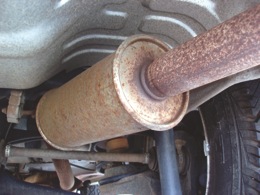Several factors are driving modern fluid maintenance services. First, a modern vehicle’s service life often extends to well over 200,000 miles and good fluid maintenance practices are, in part, responsible for that remarkable achievement. Second, car counts in many shops are declining because late-model vehicles require less scheduled maintenance and less frequent repairs. Consequently, many shops are looking at add-on services, such as fluid maintenance, to boost shop revenues.
Unfortunately, many shops have been accused of over-selling fluid maintenance services. For example, I had a customer who, for whatever reason, preferred to have his vehicle serviced at an out-of-town fast lube shop. Although his vehicle recently had the automatic transmission replaced, the fast-lube shop insisted on selling him a transmission fluid flush. Not only did they sell him the first transmission flush, they attempted to sell him a second flush on a later visit.
One reason for apparent over-selling is that many shops routinely recommend fluid maintenance services based upon the mileage of the vehicle. In addition, many vehicle owners circulate from shop to shop, so there is no continuous maintenance records kept on the vehicle. The sole exception to this situation might be information jotted into the vehicle’s OE maintenance record manual or on repair and maintenance receipts stashed in the glove box. So, it’s easy for one shop to accuse other shops of over-selling fluid maintenance, regardless of what the actual case might be.
With these thoughts in mind, let’s explore many other issues regarding fluid maintenance.
Photo 1: A visual exhaust, brake, power train inspection should be part of every extended service interval inspection.
ENGINE OIL
Extended engine oil change intervals are profoundly influencing the way we sell fluid maintenance services. Although it’s difficult for many veteran technicians to comprehend, the engine oil monitors built into the PCM’s software are doing a good job of calculating oil change intervals based upon factors like average ambient temperatures, coolant temperatures, drive times and engine loads. As a result, we’re seeing the traditional 3,000-mile engine oil change interval doubled and perhaps tripled before the vehicle returns for maintenance services.
In response to this trend, shops should be eliminating the stand-alone oil change in favor of more comprehensive maintenance and inspection schedules. Inspections would include items like filters, belts, hoses, brake friction and exhaust. Additional touches such as filling the washer fluid reservoir, cleaning the engine compartment, lubricating locks and door hinges, lubing door seals, and cleaning the battery and its cable connections would be welcome in an extended interval maintenance service. See Photo 1.
Extended service intervals have brought about four basic changes in the way we maintain vehicles in the service bay.
The first change is that the base oil and additive package of any oil must be compatible with extended service interval requirements.
Second, the oil must meet the OEM’s lubrication requirements for highly stressed engine components like camshafts and piston/ring assemblies.
Third, the oil filter itself must meet extended interval requirements.
Last, and most important, most fluids in a modern vehicle are often application-specific and, in many cases, designed for extended interval use.
AUTOMATIC TRANSMISSIONS
While some manufacturers consider automatic transmission oil as a “lifetime” fluid, other manufacturers believe that it should be changed according to mileage and usage. To illustrate, trucks used for towing heavy loads definitely need more frequent transmission fluid maintenance because the transmission obviously operates at a higher temperature, which tends to oxidize and deplete the fluid’s additive package much more rapidly.
All too often, a customer might request a transmission flush in the belief that flushing will cure a shifting or slippage complaint. In reality, if the fluid is badly burned or contaminated, flushing probably won’t compensate for the mechanical wear that has taken place. On the other hand, if the fluid simply appears dirty from normal use, a flush might be recommended.
The obvious question is whether the transmission oil pan should always be removed for service. Many auto manufacturers believe, for example, that replacing the oil in the pan at regular intervals maintains the additive package in the oil. My opinion is that the oil pan should be removed so it can be inspected for wear debris, the filter can be replaced, and the valve body screws checked for correct torque. If the transmission experiences severe service, I would recommend removing the oil pan and performing the above services.
Last, far be it from me to recommend anything but the OEM-specified automatic transmission fluid for a fluid replacement. While the vehicle owner’s manual or a repair database might recommend a generic fluid for topping off the fluid level, it generally will not recommend that same generic fluid for fluid replacement.
MANUAL TRANSMISSIONS
In years past, the conventional “90-weight” transmission oil was used in all manual transmission applications. Beginning about 25 years ago, transmission manufacturers began changing over to lower-viscosity oils to reduce rotating friction in their transmissions and to increase fuel economy. In that era, some manufacturers recommended engine oil and even automatic transmission fluid for their manual transmissions.
Most currently recommend synthetic-based oils to improve lubrication and reduce rotating friction. Because transmission gear shift synchronizers are designed for specific types of lubricants, a vehicle owner would likely experience hard shifting on cold mornings if a substitute lubricant is installed.
Today, we have very sophisticated five and six-speed, high-performance manual transmissions that require application-specific lubricants. In addition, we also have many automatic transfer cases in 4WD applications that might use friction clutches to engage front drive trains and equalize input and output shaft speeds. Here again, the oil must be formulated to allow smooth 4WD engagement. So the lesson to be learned here is that it’s always best to use the recommended fluid for any manual transmission or automatic transfer case application.
The Important Things You Need To Know About Fluid Maintenance Issues
